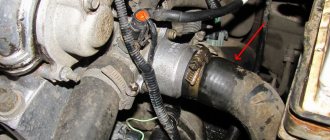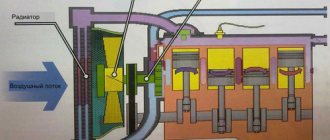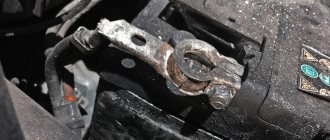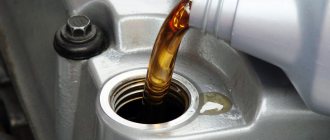The average car enthusiast rarely cares what color the smoke comes from the exhaust pipe of his car. As a rule, more significant things attract his attention. But to the attentive observer, the color of this smoke can tell a lot. The main thing is to know where to look.
- 2 Engine diagnostics: causes of white smoke
- 3 Appearance of blue (gray, gray) smoke
- 4 What does black smoke mean?
Normal composition of exhaust gases from diesel and gasoline engines
It may vary. This depends both on the type of car and on the requirements of environmental standards, which are becoming stricter literally every year. As a result, what was considered quite normal two years ago may be completely unacceptable today. However, there is a set of basic indicators on which any exhaust gas analysis is based. Let's look at them in more detail.
When fuel burns, CO2 and water are produced. These are two oxidation reaction products that are obtained under ideal conditions with complete combustion of the fuel mixture. But in an engine, an ideal reaction is impossible in principle, since the fuel combustion process there is dynamic. It is accompanied by sudden changes in volume (during the movement of the pistons), changes in pressure, and even a change in the thermal conductivity of the burning mixture itself. Because of all this, a lot of foreign substances appear in car exhausts, the main ones being CH and CO.
- CO is carbon monoxide, or carbon monoxide. In fact, this is fuel that began to burn, but never burned out, because it did not attach another oxygen molecule to itself and did not oxidize to CO2.
- CH is all other hydrocarbons. It is “all the others”, and not just one hydrocarbon. In fact, these are the remains of fuel, which, unlike CO, did not even begin to burn.
These indicators are reflected on the displays of most automobile gas analyzers. For example, this is what the gas composition of a working injection engine looks like on the display of a gas analyzer. The values on the display cannot be called reference values, but they are within normal limits:
Injection car, CO and other components are within normal limits
And here is a summary table of the composition of normal exhaust gases for cars with engines of various types:
| Gasoline | Diesel | |
| N2, vol % | 74–77 | 76–78 |
| O2, vol% | 0.3–8.0 | 2.0–18.0 |
| H2O (vapor), vol% | 3.0–5.5 | 0.5–4.0 |
| CO2, vol% | 0.0–16.0 | 1.0–10.0 |
| CO, vol% | 0.1–5.0 | 0.01–0.5 |
| Nitrogen oxides, vol% | 0.0–0.8 | 0.0002–0.5000 |
| Hydrocarbons, vol% | 0.2–3.0 | 0.09–0.500 |
| Aldehydes, vol% | 0.0–0.2 | 0.001–0.009 |
| Soot, g/m3 | 0.0–0.004 | 0.01–1.10 |
| Benzpyrene - 3.4, g/m3 | 10–20x10-6 | 10x10-6 |
Smoke from the exhaust pipe after stopping the engine
Quite a few car enthusiasts have noticed (usually by accident) that immediately after stopping the engine, a small stream of white or dark smoke comes out of the exhaust pipe. This stops only after a few minutes. What does such smoking indicate if the engine is not running, and in principle nothing should be smoking?
There are only two answers to this question:
- These are condensate vapors.
- Something is burning out in the catalyst.
The generation of steam from the exhaust pipe may well begin immediately after stopping the engine. But this requires certain conditions. It may be that there is water in the “banks” of the exhaust system. It often accumulates there when the car is used for short trips - the condensate does not have time to properly evaporate from the pipe, and accumulates at the bottom of the “cans”. To get rid of water in the exhaust pipe, drill a hole in it; you must regularly carry out more or less long trips so that all the moisture has time to be removed from the system.
Regarding the burning out of any rubbish in the catalyst. This is a completely normal situation if the engine “eats” oil, or you fill with extremely low quality gasoline. This whole thing ends up in the catalytic converter, and after stopping the engine it continues to burn out or evaporate. A similar situation arises if you press the gas pedal aggressively and then immediately turn off the engine.
Consequences. The worst thing that can happen is accelerated clogging of the catalyst. To prevent this from happening, and also to avoid seeing smoke from the exhaust pipe after stopping the engine, let it idle for a while before turning it off.
Engine diagnostics: causes of white smoke
Most often it turns out to be an ordinary ferry
If your gasoline or diesel engine is just warming up, white smoke is normal. To be precise, this is not smoke, but steam. If it comes out of the pipe, then the humidity level in the exhaust pipes of the car is very high. Since the exhaust system has not warmed up, moisture begins to gradually condense from the air, resulting in visible white vapor. After the exhaust system warms up well, it disappears. Here you should definitely mention the air temperature. If the outside temperature is below 8°C, then steam will flow from the pipe even when the engine is well warmed up. And if it’s thirty degrees below zero, then steam will come out, and it will be very thick and white. None of this is a sign of engine malfunction.
But another situation is also possible, when it is smoke, not steam, that comes out of the car. This happens because coolant somehow gets into the fuel system of the car. Then white smoke appears, and its color and density directly depend on the chemical composition of the antifreeze used, on the temperature outside and on the time of day, that is, on the lighting. It is not difficult to understand that it is not steam: the steam disappears instantly, and the smoke leaves behind a light mist. There are two reasons for mixing antifreeze with fuel.
- The gasket under the cylinder block cover has lost its tightness.
- Cracks have formed in the cylinder block housing due to high temperature or due to fatigue stresses in the metal.
If the car owner notices white smoke, you should not continue driving the car. If fatigue cracks appear on body parts, they can grow very quickly (this is the main feature of the mechanism of fatigue failure of metals). In addition, when antifreeze gets into the engine, it no longer runs on pure fuel, but on a special emulsion, as a result, the wear of engine parts is significantly accelerated, and after a couple of hundred kilometers it will need major repairs. To fix the problems, the car will have to be taken to a car service center. If the car owner can still replace the gasket under the cylinder block cover on his own, then searching for cracks in body parts is a hopeless task, since they can rarely be seen with the naked eye. This cannot be done without special equipment and qualified specialists.
Types of smoke from the exhaust pipe
If you ask a specialist who “communicates” with cars every day how a gasoline engine can smoke, he will immediately come up with at least a dozen different options:
1. White steam. 2. White thick smoke. 3. Smoke “in the cold”. 4. Blue or gray smoke. 5. Black smoke. 6. Smoke from the exhaust after changing the oil. 7. Smoke after stopping the engine. 8. Smoke from the exhaust pipe after a long period of inactivity. 9. Smoke after removing the catalyst. 10. Smoke under load.
But if you ask him what the exhaust of a working car looks like, he will immediately say that it does not. If all components and systems work as they should, it is only possible to call smoke what flies out of the chimney. There is nothing in its composition that could be noticed by the eye. The exhaust is completely transparent, that is, invisible. It can only be felt tactilely by raising your hand directly to the pipe.
The only exception is wet or cold weather. Therefore, this is where we begin to study the nature of smoke from the exhaust pipe of a gasoline engine.
The appearance of blue (gray, gray) smoke
The cause is usually excess oil.
As a rule, there is one reason: engine oil gets into the cylinders. The engine can be either injection or diesel. The shades of oil smoke can vary from gray to light blue. It is not difficult to recognize that the problem is in the oil: you just need to measure its consumption and compare it with the consumption before the smoke appeared. The possible picture is this: if approximately 0.5 liters of oil are consumed per 100 km, then blue smoke is noticeable only after accelerating. If oil consumption exceeds 1 liter per 100 km, then smoke is visible in any driving mode. How does oil get into the combustion chambers? There are several options.
- The upper compression rings on the pistons are worn.
- One or more valves are worn out.
- The seal of the valve stem seals is broken.
If the rings on the pistons are worn, this leads to a decrease in compression. In this case, the crankcase gas pressure, on the contrary, increases. But there are several nuances here.
- If a lot of oil enters the cylinders, then it itself can seal the gaps that arise between the parts. If the gaps are small, then due to such compaction, compression when measured by instruments may well be within normal limits, which makes it much more difficult to identify the real cause of dark smoke.
- Second point: blue smoke can appear even if the car is new. But, as a rule, it is visible only when the engine warms up. After that it disappears. Reason: the rings on the pistons are still new. This means they haven’t gotten used to it properly. As they heat up, they expand, begin to fit more tightly to the inner surface of the cylinders, compression increases and the smoke disappears.
The valves in the engine wear out over time. The same applies to valve stem seals: their rubber loses its elasticity over time and begins to crumble or delaminate.
All of the above problems can be solved by replacing rings, valves and caps. The car owner can easily do all this with his own hands. Specialist assistance may only be required when replacing valves. The fact is that new valves require careful grinding. This is a very painstaking job, so the help of a specialist at this stage will be very helpful.
Gray smoke from a chimney is a special case associated with the same excess oil.
Smoke “on cold”
The presence of smoke when starting a cold engine for the first time in the morning is not always a symptom of a malfunction. If it is white, then it is just condensation vapor, which was mentioned above.
Even bluish smoke is considered quite normal if the engine is really cold. It indicates that the parts of the piston group have not yet warmed up and have not expanded, that is, there is a microscopic gap between them. Through it, a little oil enters the combustion chambers, the combustion of which manifests itself in the form of a gray or blue haze. As the engine warms up, it should disappear. This is the norm.
Black smoke “when cold”, if it disappears after warming up, also does not bode well. Unless there are some problems in the engine power supply system. Very often, devices responsible for “warm-up speed” fail. If they are “dead” or do not work correctly, then a too rich air-fuel mixture is simply supplied to a cold engine. Enriched is when there is not enough oxygen for complete combustion of a portion of gasoline. It is unburned fuel that gives off black smoke at the start.
Smoke from the exhaust pipe after removing the catalyst
Removing the catalytic converter is not something outlandishly unacceptable in our country. Well, yes - the car begins to pollute the air more than ever. But who is monitoring this? At least as of this writing, no one. And due to low-quality fuel and other unfavorable operating conditions, this part wears out very quickly. It usually gets clogged. Replacing it costs a lot of money. But removal is easier, cheaper, and also noticeably adds power to the car.
But let's get back to the smoke from the exhaust pipe. After all, it often happens that after removing this very catalyst, the engine begins to emit black smoke. Where is he from? And it all comes from the same place - because of the over-enriched air-fuel mixture. The thing is that the operation of the catalyst is “monitored” by electronics using sensors. And when this element is removed, they forget to “inform the electronics about it.” Accordingly, the system “sees” that something is wrong and begins to increase the dosage of gasoline, that is, it enriches the air-fuel mixture. Well, you already know what happens from this.
The problem can be solved very simply - by reflashing the BC or resetting errors that the electronics will generate anyway when they “do not detect” the catalyst.
Smoke from the exhaust pipe after a long period of inactivity
It is generally easy to establish the reason here. When the car is not used for a long time, the first start will always be accompanied by copious smoke emissions from the exhaust pipe. By long downtime here we mean a break of at least a couple of weeks. Why does it smoke?
If the problem disappears as the engine warms up, then there is nothing wrong with such smoke. Where it comes from is described above in the section on cold starts. You shouldn't expect any unpleasant consequences.
Completely different conclusions will have to be drawn if, after a long period of inactivity, the car continues to smoke and smoke without stopping. This most likely indicates that the oil scraper rings are stuck and are no longer doing their job. It’s not worth driving with such a problem, since in the end not only the rings, but also the entire engine will become damaged.
Again, sometimes decarbonizing the engine can solve a similar problem. The rings need to be slightly “soaked” so that they come out of their grooves and “spread their wings”. Usually, if the engine did not smoke before it was parked for a long time, then decarbonization always helps. If it doesn’t help, perhaps you simply didn’t pay attention to the smoke from the exhaust pipe before, but it was already there before. In such cases, only piston repair, as well as checking and possible replacement of the valve stem seals, will save you.











